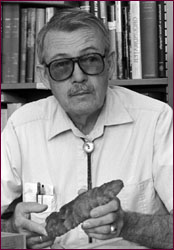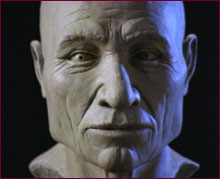
|

|
C. Vance Haynes, Jr. Regent's Professor, Department of Anthropology and Geosciences, University of Arizona On October 3, 1996, upon hearing about the Army Corps of Engineers intention of repatriating the Kennewick Man bones, I wrote to Maj. Gen. Ernest J. Harrell, Commander of the North Pacific Division. I pointed out that if it really is as old as the radiocarbon age indicated, "its value to science, and therefore to better understanding the peopling of the Americas, is paramount. Our knowledge regarding this important and fascinating question is based upon the scientific study of less than a dozen specimens found over the last 100 years. Furthermore, most of the specimens over 8,000 years old are either poorly preserved or are subadults and, therefore, much less informative than well preserved specimens." For these reasons, the Kennewick skeleton should be studied by some highly qualified physical anthropologists before it is reburied. Furthermore, the population affinities of the skeleton are very important questions that, even if morphological data are inconclusive, may be answerable by DNA testing if the bone is adequately preserved. This could also determine to whom the remains should be repatriated. Detailed study and analysis of the geologic context of the Kennewick find site is important for confirming the age indicated by radiocarbon dating and for determining the nature of the occurrence, i.e., accidental burial by river processes or interment via human activity. Geological strata are like pages in the book of time and need to be read by qualified experts to learn what happened at the Kennewick find site.
For me and many scientists, the understanding of nature is based upon scientific investigations that add to humankind's ever increasing fund of knowledge. The fund is ever changing as new generations of scientists add to, debate, and reinterpret the data. For those who have devoted their lives to better understanding the peopling of the New World, the Kennewick find is a rare opportunity for a significant increase in knowledge about who the early Americans were and how they relate to living tribes. Does Race Exist? | Meet Kennewick Man Claims for the Remains | The Dating Game | Resources Transcript | Site Map | Mystery of the First Americans Home Editor's Picks | Previous Sites | Join Us/E-mail | TV/Web Schedule About NOVA | Teachers | Site Map | Shop | Jobs | Search | To print PBS Online | NOVA Online | WGBH © | Updated November 2000 |
 Vance Haynes
Vance Haynes
 Was Kennewick Man buried by nature or by his
compatriots? Only detailed study of the riverside site
where he was found will tell, says Haynes.
Was Kennewick Man buried by nature or by his
compatriots? Only detailed study of the riverside site
where he was found will tell, says Haynes.